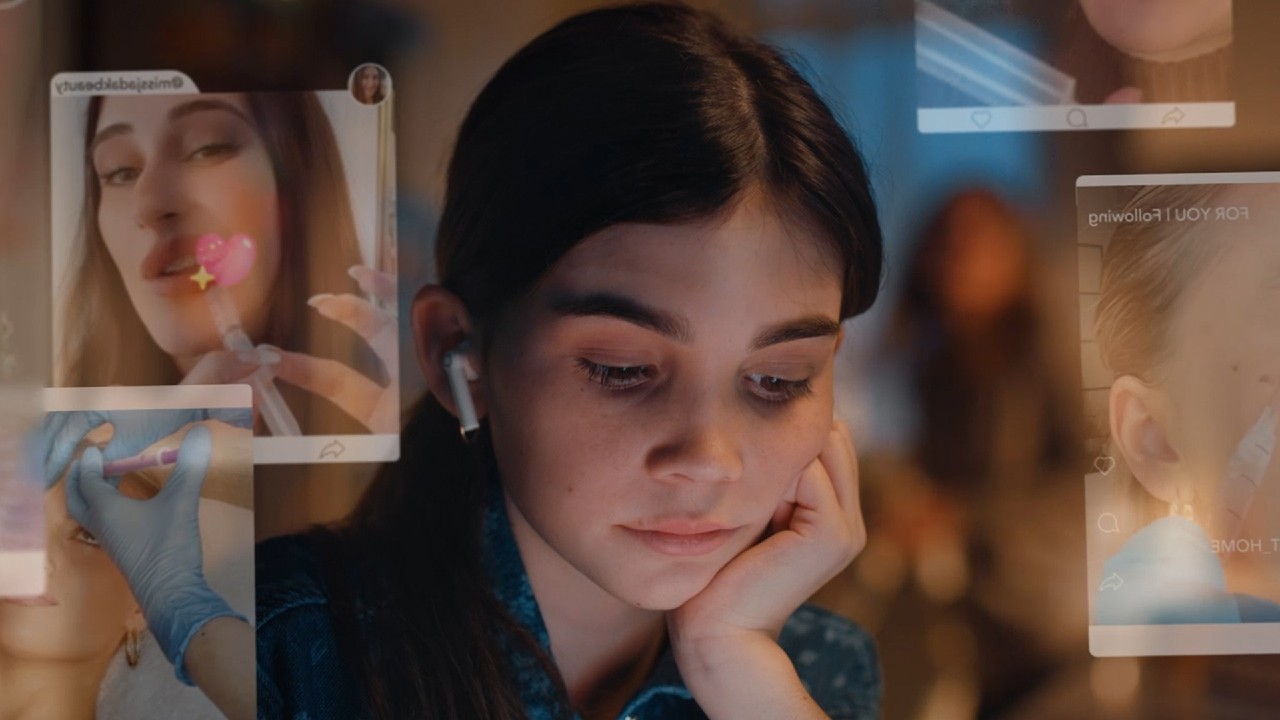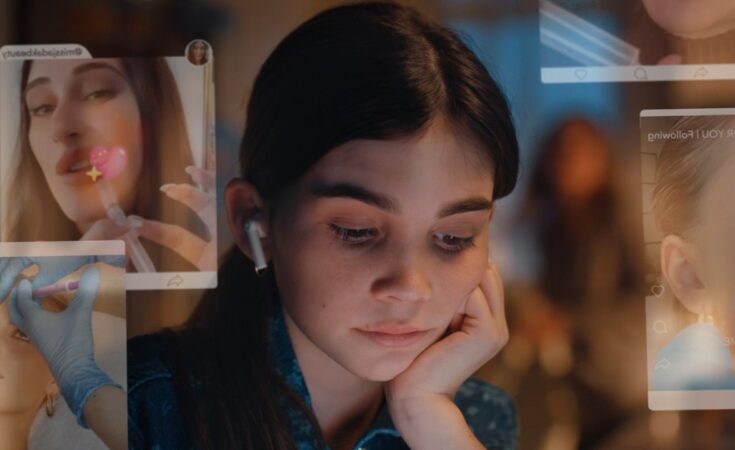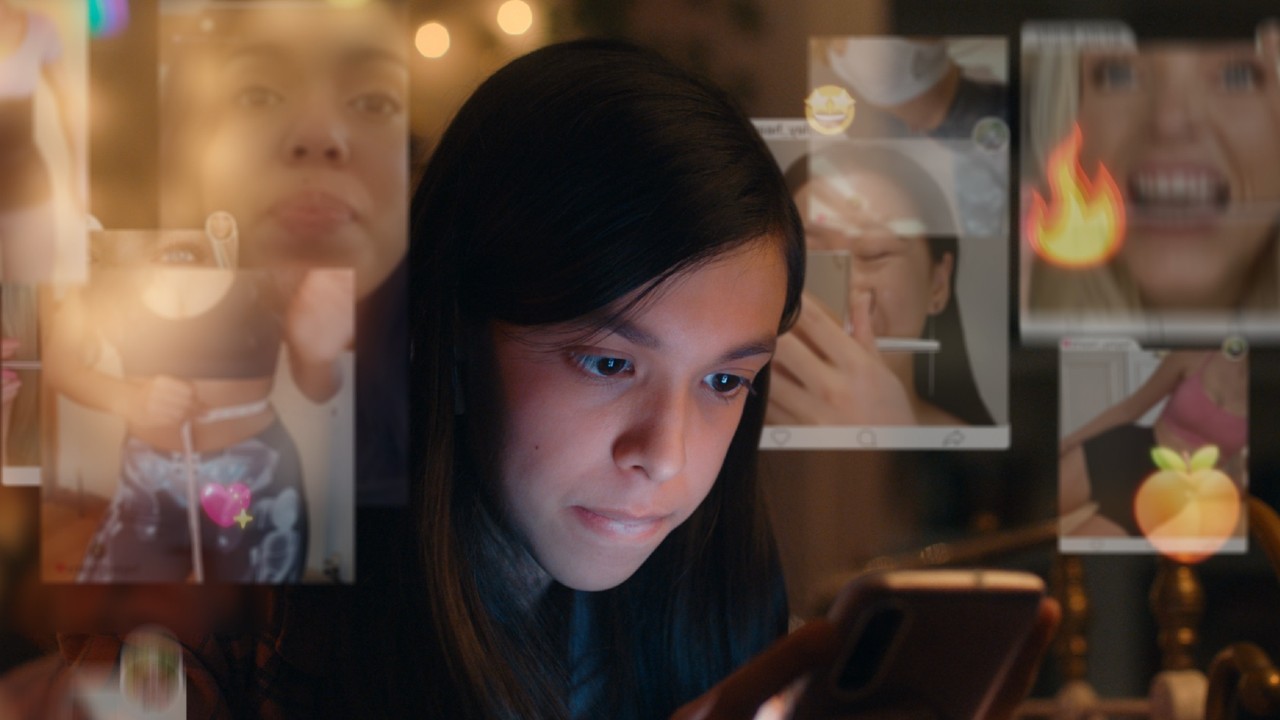Plus a step-by-step guide on how to talk to your teen about, beauty standards, social media and building self-esteem.

Half of Canadian tween and teen girls spend more time on social media each day than they do hanging out with their friends in person. And most of that time is spent watching videos on Youtube and TikTok.
While not all social media is bad—it can be a great way for kids to stay connected to family and friends, learn new things (hello TikTok dances) and showcase their creativity—it also exposes them to content that’s been edited and carefully curated creating beauty standards that are impossible to live up to.
Consider this: According to Dove Self-Esteem Project’s most recent survey, girls take an average of 14 selfies before posting one on social media. One in four says they don’t think they look good enough without photo editing, one in two girls say idealized beauty content on social media causes them low self-esteem, and seven in ten girls have felt better after unfollowing idealized beauty content on social media.. That’s why The Dove Self-Esteem Project, the largest provider of body confidence education globally, launched the #DetoxYourFeed campaign, empowering teens to define their own beauty standards and to unfollow content that’s making them feel bad about themselves.
As a parent, you may feel powerless compared to the influence of social media. But 70 per cent of girls say they actually want their parents to talk to them about how to deal with the unrealistic beauty content they’re being exposed to online. Here are some tips for how to talk to your teen about toxic beauty standards and social media.
Highlight the highlight reel
Sit with your kid and go through their feed, asking them which accounts seem authentic and which people might be using editing tools to make themselves look brighter, smoother or even skinnier than they are. Point out that many people spend a lot of time choosing and preparing the photos they post—and they don’t paint a picture of what that person’s life is really like. Consider: does the content you follow make you feel good about yourself?
Focus on positive use
Your kid’s relationship with their phone is rock solid. You’re not going to succeed in prying it out of their hands, so it’s important to help them use it in positive ways. Talk to them about using social media to connect with friends or to engage with or create authentic content that interests them—no filters, needed. Kids might be surprised that they can contribute to positive change just by posting things that are uplifting and real.
What your kid sees on their social feeds is more influential to them than celebrities and TV. But as a parent, you have the ultimate influence and kids need our help more than ever to help them make good content choices and engage with social media in a positive way.
Photo: Dove
Detox your feed
Almost three-quarters of girls say they feel better after unfollowing toxic beauty advice online. Want to help your kid—and yourself—reduce the amount of damaging beauty messages that pop up in their social media feed? Here’s how:
Prep
Do your homework by signing up for TikTok, Instagram, YouTube, Facebook, Snapchat and Twitch. Follow the accounts your kid follows.
Chat
Get ready to talk to your teen about social media. Download The Confidence Kit, a free Dove Self-Esteem project workbook and tool, empirically reviewed by body image experts and psychologists, featuring a new section, “Detox Your Feed: Talking to Your Kids About Toxic Social Media Advice, meant to help parents navigate difficult conversations with their child. Then watch Detox Your Feed: The Parents’ Guide, a three-minute video for parents, caregivers and mentors about how to talk to young people about the harmful effects of social media.
Once you’re ready, have an open and honest discussion. Remember, this isn’t about control—don’t tell them to spend less time online, or delete certain apps. You want to empower your teen to make good decisions about their social media use.
Detox
Spend 10 minutes with your teen scrolling through your feeds and talking about how you feel. Some content will inspire and some might make you feel inadequate or inferior. Together, unfollow or hide the posts that brought up negative feelings. If they (and you) feel better after not seeing those posts for a week, unfollow them for good.
Repeat
Set calendar reminders to #DetoxYourFeed once a month and spread the word to other parents, guardians and mentors. Your kid can also share what they’ve learned with their friends and followers. Similarly, when posting, consider your own content and the impact it will have on others.
Dove believes that no girl should follow anyone into thinking she isn’t beautiful. Help your daughter detoxify her feed with the Dove Self-Esteem Project. Visit dove.com/detoxify to learn how. #DetoxYourFeed
The Dove Self-Esteem Project is the largest provider of body confidence education globally, having reached more than 82 million young people across 150 countries to-date. By 2030, Dove will have helped 250 kids and teens boost their self-esteem through educational programming and no-cost resources. Dove has been fighting to end narrow definitions of beauty that threaten body confidence and self-esteem for 30 years.
Stay in touch
Subscribe to Today’s Parent’s daily newsletter for our best parenting news, tips, essays and recipes.
= 0;if(!is_postback){return;}var form_content = jQuery(this).contents().find(‘#gform_wrapper_13’);var is_confirmation = jQuery(this).contents().find(‘#gform_confirmation_wrapper_13’).length > 0;var is_redirect = contents.indexOf(‘gformRedirect(){‘) >= 0;var is_form = form_content.length > 0 && ! is_redirect && ! is_confirmation;var mt = parseInt(jQuery(‘html’).css(‘margin-top’), 10) + parseInt(jQuery(‘body’).css(‘margin-top’), 10) + 100;if(is_form){jQuery(‘#gform_wrapper_13’).html(form_content.html());if(form_content.hasClass(‘gform_validation_error’)){jQuery(‘#gform_wrapper_13’).addClass(‘gform_validation_error’);} else {jQuery(‘#gform_wrapper_13’).removeClass(‘gform_validation_error’);}setTimeout( function() { /* delay the scroll by 50 milliseconds to fix a bug in chrome */ jQuery(document).scrollTop(jQuery(‘#gform_wrapper_13’).offset().top – mt); }, 50 );if(window[‘gformInitDatepicker’]) {gformInitDatepicker();}if(window[‘gformInitPriceFields’]) {gformInitPriceFields();}var current_page = jQuery(‘#gform_source_page_number_13’).val();gformInitSpinner( 13, ‘https://www.todaysparent.com/wp-content/plugins/gravityforms/images/spinner.gif’ );jQuery(document).trigger(‘gform_page_loaded’, [13, current_page]);window[‘gf_submitting_13’] = false;}else if(!is_redirect){var confirmation_content = jQuery(this).contents().find(‘.GF_AJAX_POSTBACK’).html();if(!confirmation_content){confirmation_content = contents;}setTimeout(function(){jQuery(‘#gform_wrapper_13’).replaceWith(confirmation_content);jQuery(document).scrollTop(jQuery(‘#gf_13’).offset().top – mt);jQuery(document).trigger(‘gform_confirmation_loaded’, [13]);window[‘gf_submitting_13’] = false;}, 50);}else{jQuery(‘#gform_13’).append(contents);if(window[‘gformRedirect’]) {gformRedirect();}}jQuery(document).trigger(‘gform_post_render’, [13, current_page]);} );} );]]>
Read The Full Article Here




































